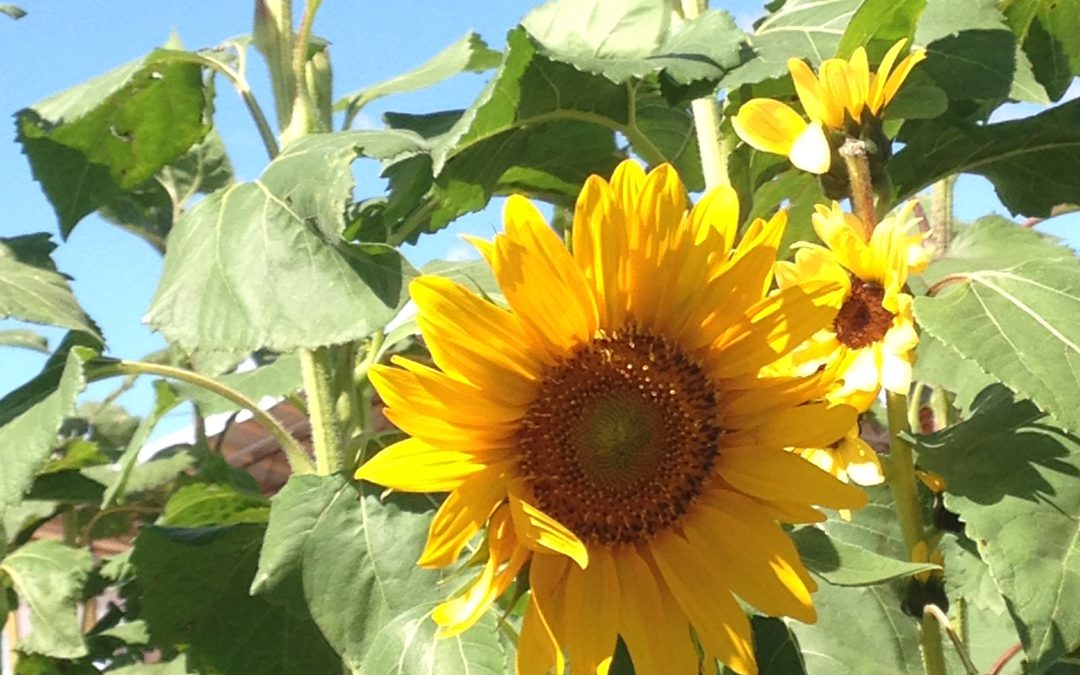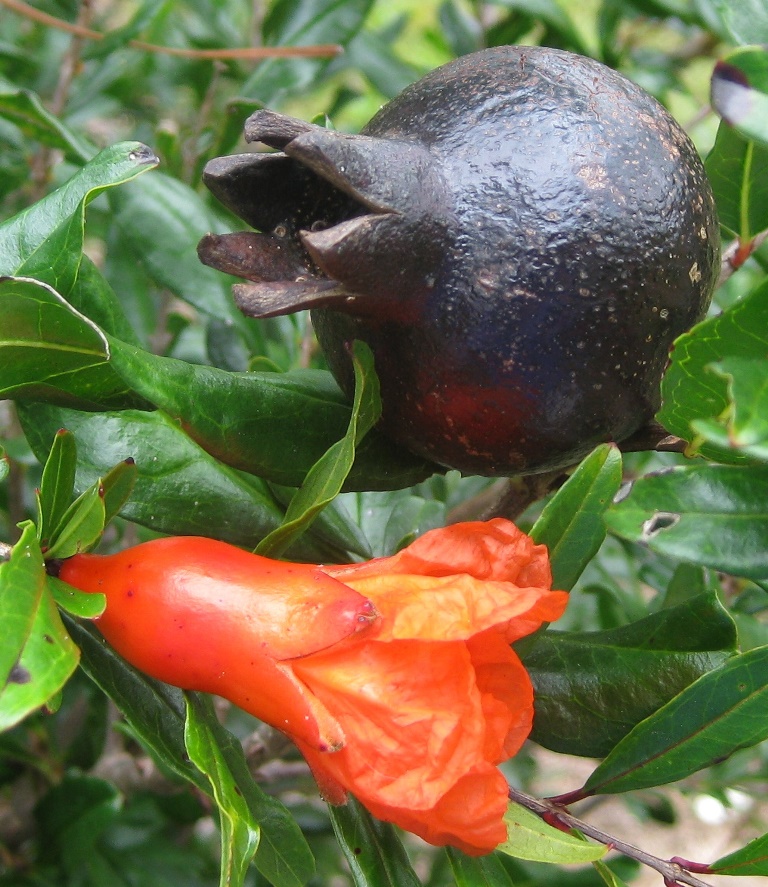
by Pat Williams | Sep 14, 2020
Did you ever want to grow something for the dinner table in your yard, but said “I don’t have the space”, or “I don’t have the time”, or “it seems like a lot of hard work or even I have restrictions because of the homeowner’s association I live in”?
If so, then foodscaping might be the answer to growing food in your yard. Landscape beds have traditionally been planted with trees, shrubs, groundcovers, flowers and even vines while edibles were relegated to garden plots containing vegetable and herbs. Foodscaping is a growing trend that takes edibles from formal vegetable plots into landscape beds.
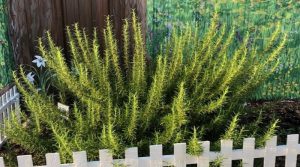
Rosemary in the UF/IFAS Extension Wakulla entrance bed.
Foodscaping works for both newly planted landscapes and established ones. Only a few square feet are needed to begin. When most new landscapes are planted, they space plants apart for future mature growth. Until the shrubs fill in, you have usable space. The same holds true for established landscapes. Sometimes there is empty space. Whatever the cause, there now is a foodscaping opportunity.
Some of the best examples of beginning foodscaping plants are herbs and greens. A good number of cooking herbs are perennials and can add seasonal accent to the yard and flavor in the kitchen. Some examples are oregano*, thyme, rosemary, sage, lemongrass, chives, garlic chives, winter savory, mints*, chamomile, lavender, and lovage (* containers will help control the spread).
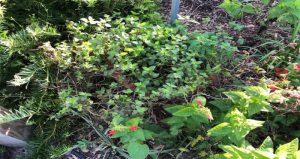
Potted chocolate mint between red salvia and yew.
Some annuals herbs include dill, fennel, cilantro/coriander, basil, garlic, sweet marjoram (perennial but acts like an annual in colder areas) and tarragon. These herbs are compact, just one or two plant in a space with a bit of room to grow is all that’s needed. Other vagetables that offer a seasonal groundcover look are greens like assorted leaf lettuces, spinach, mustard, bok choy, collards, sorrel, burnet, parsley and kale. These herbs and vegetables attract the senses with their colors, textures, and fragrances.
Once you get the hang of these easier foodscaping plants, you can branch out into more traditional garden favorites like potatoes, sweet potatoes, green beans, peas, beets, radishes, celery or anything that fits the space and cultural/environmental requirements.
Besides having some quick and easy items to eat from the yard, you are also doing your bit for the environment by reducing vehicle travel, which reduces your carbon footprint. And if you have extra, share with your neighbors and encourage them to foodscape as well. For more information check out https://gardeningsolutions.ifas.ufl.edu/design/types-of-gardens/foodscaping.html.

by Larry Williams | Aug 14, 2020
Oleander caterpillars, which are active on some oleanders during summer, can provide a number of gardening lessons.
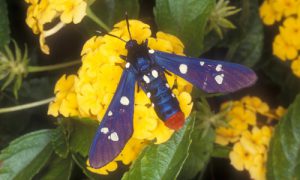
Oleander caterpillar moth on lantana flower. Photo credit: James Castner, UF
The adult moth is striking in appearance. The bluish to purplish moth has white dots on its black wings. The moths resemble wasps as they fly in and around oleander shrubs.
It’s the orange caterpillars with black spots and black hairs that cause problems for some gardeners.
Caterpillars are the larval stage of butterflies and moths. In order to enjoy watching butterflies and moths feeding on the nectar of flowers, some of the caterpillars must survive to become adult butterflies and moths. This is lesson number one.
Oleander caterpillars usually only feed on oleander plants. Oleanders are native to areas of Europe and Asia. This is lesson number two.
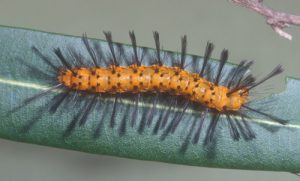
Oleander caterpillar, Photo credit: Paul Choate, UF
Oleander caterpillars benefit by us planting their food source in Florida.
This relationship between pest and plant is referred to as the key plant, key pest concept. Some other examples include St. Augustinegrass and chinch bugs, gardenias and whiteflies, crape myrtles and crape myrtle aphids, azaleas and azalea caterpillars, camellias and tea scale, roses and black spot, pecans and pecan scab, squash and squash vine borers.
Understanding this concept can be helpful in designing a “low maintenance” landscape.
When you plant roses, you plant everything that goes with roses, including the time and money required to maintain them. This applies to St. Augustinegrass, pecan trees, squash and oleanders. This is lesson number three.
Oleander caterpillars can temporarily damage the appearance of oleanders. But they cause no long-term damage for the plant. This is lesson number four. The damage is aesthetic. Oleander caterpillars can consume great numbers of leaves. However, if the plant is otherwise healthy, new leaves will be produced and the plant will continue to grow. The damage is temporary; there will be no evidence the plant ever had a problem.
To spray or not to spray for oleander caterpillars has to do with a person’s tolerance level.
If you can’t tolerate having oleander caterpillars around and the temporary aesthetic damage they cause, consider the use of Bacillus thuringiensis. It is sold under a number of brand names and many times is referred to as Bt. This bacterium only controls caterpillars so it is friendlier for the beneficial insects. When using any pesticide, always follow the label directions and precautions.
Here are links to UF/IFAS Extension publications with more info.
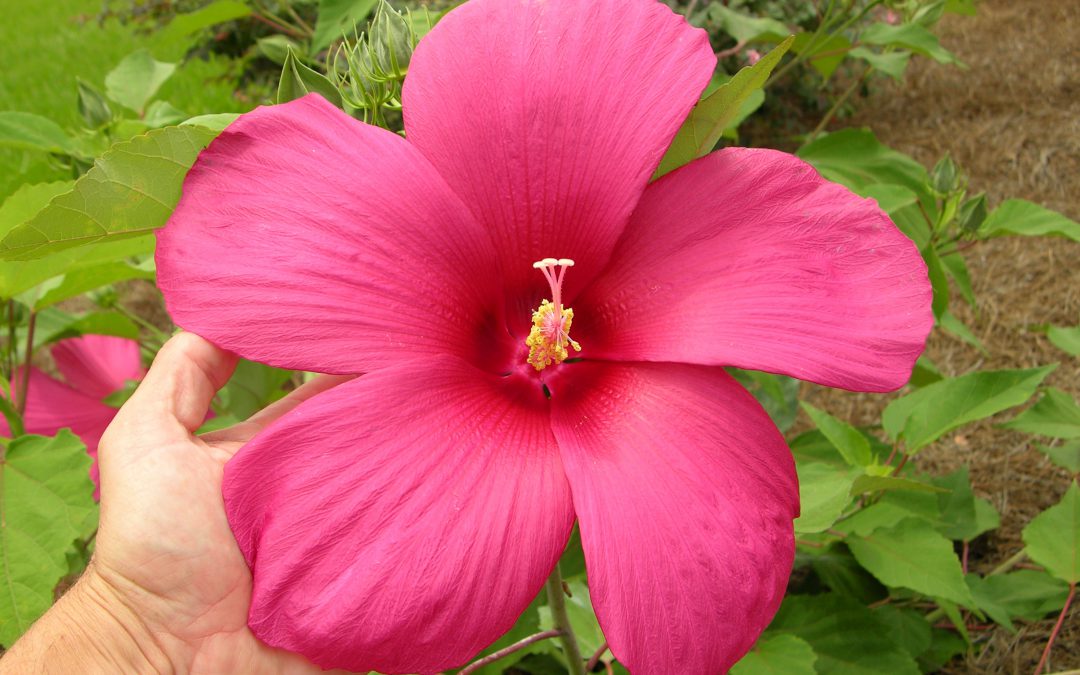
by Gary Knox | Jul 30, 2020
The dog days of summer are here with high temperatures and humidity. While this sultry weather forces humans to retreat to air conditioning, our gardens suffer because the high night temperatures cause temperate plants to stop flowering, lose vigor and pause growth. By August, many plants in the garden look as bedraggled and wilted as we feel after mowing the grass or trying to weed.
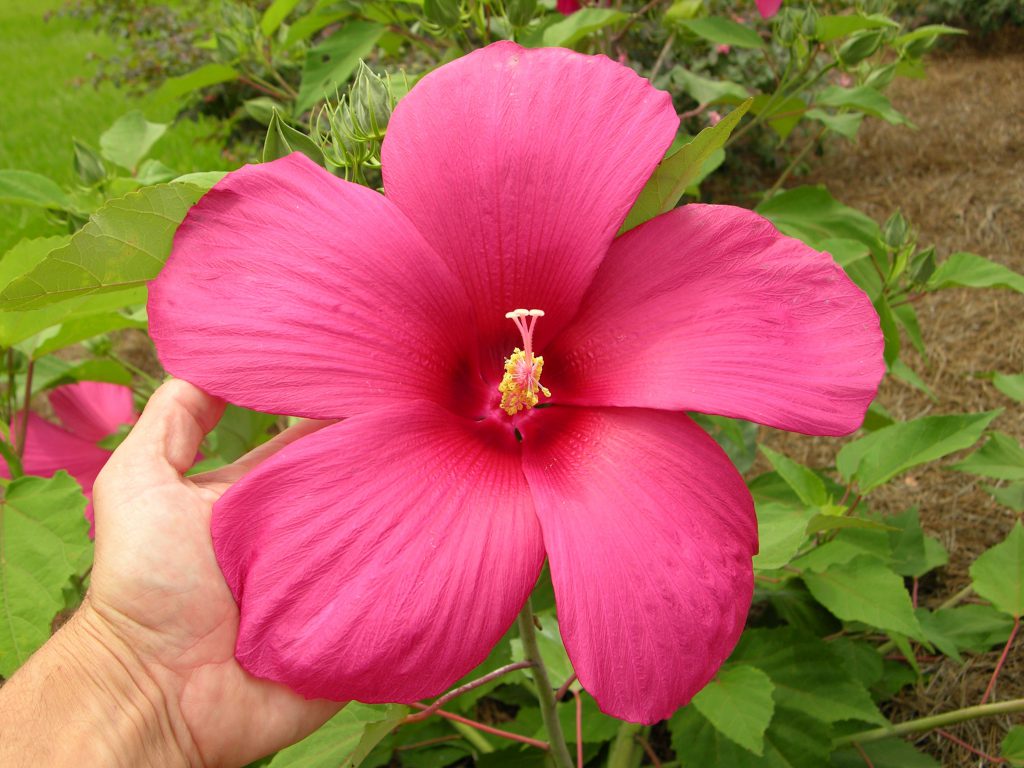
‘Moy Grande’ Hardy Hibiscus (Hibiscus spp.)
All is not lost: the fading flowers and fizzling foliage of traditional garden plants can give way to heat-loving tropicals! Plants that are native to tropical and subtropical climates are naturally adapted to heat, humidity and rain, easily standing up to the worst that our north Florida summers can throw at them. Tropicals offer bright flowers, bold texture and exuberant growth just when the rest of your garden melts in the heat. Tropical plants include trees, shrubs, vines, perennials, groundcovers or annuals, and there are tropicals for full sun, part sun or shade.
Tropical Plants for North Florida
Top tropicals for north Florida gardens are palms, bananas, hibiscus, and gingers. Palms are the iconic symbol of the Tropics. Native subtropical palms can give you the palm vibe without the worry of cold hardiness. These include cabbage palm and related palmettos in the genus Sabal, paurotis palm (Acoelorrhaphe wrightii), saw palmetto (Serenoa repens) and needle palm (Rhapiophyllum hystrix). Non-native European fan (Chamaerops humilis), jelly (Butia spp.), windmill (Trachycarpus spp.), date (Phoenix spp.), Washington (Washingtonia spp.) and other palms also grow well and are cold hardy in north Florida. Most palms grow best in full to part sun but palmettos, saw palmetto and needle palm can handle more shade. Saw palmetto, needle palm and most palmettos grow 3 to 6 ft. tall. European fan, jelly, paurotis and windmill palms grow 10 to 20 ft. tall, while cabbage, Washington and date palms often exceed 40 ft. For best appearance, palms often require special fertilizer (https://edis.ifas.ufl.edu/ep261).
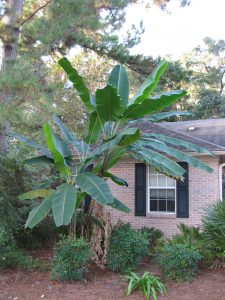
Hardy Yunnan Banana (Musa yunnanensis)
Characterized by their large, bold leaves, bananas are another plant group associated with tropical weather and full sun. Hardier forms of banana that thrive here include Chinese yellow (Musella lasiocarpa), pink (M. velutina), basjoo (Musa basjoo), Yunnan (M. itinerans), and hardy Yunnan (M. yunnanensis). Chinese yellow and pink bananas grow about 5 ft. or more in height, whereas the others have mature heights of 20 ft. or more. Bananas benefit from planting in a location that blocks strong winds so as not to shred the leaves. Depending on the severity of our winter, these bananas may lose some or all leaves but they usually regrow in late spring once warm weather arrives.
The large, colorful and exotic-looking flowers of tropical hibiscus (Hibiscus rosa-sinensis) are associated with the tropics, though this hibiscus is less cold hardy here and is perhaps best enjoyed as a container plant. Other notable hibiscus for north Florida include Confederate rose (H. mutabilis), rose-of-sharon or althea (H. syriacus), and hardy hibiscus (many hybrids of H. moscheutos and other native species). Varying in height from 3 (hardy hibiscus) to 12 ft. (confederate rose), hibiscus thrives in full sun and moist, even wet, soil. Their summer flowers come in colors of white, lavender, pink and red and range in size from a few inches (althea) to the size of dinnerplates (hardy hibiscus)! Except for rose-of-sharon, these hibiscus die back in winter and re-emerge again in late spring.
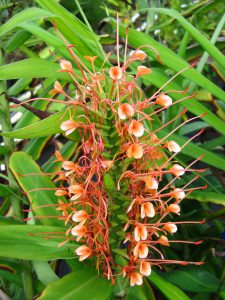
‘Disney’ Ginger Lily (Hedychium coccineum)
Gingers are also symbolic of the tropics. Many produce complex or colorful flowers and often flowers or other plant parts are aromatic. Ginger lily (Hedychium spp.), spiral ginger (Costus spp.) and shell ginger (Alpinia spp.) have fragrant and colorful racemes or spikes of flowers that appear at the tops of stems 4 ft. to 6 ft. or more tall. Hidden ginger (Curcuma spp.) and true ginger (Zingiber spp.) are lower growing with flowers appearing in “cones” on tops of separate, short stems. Finally, the patterned leaves of peacock ginger (Kaempferia spp.) make a beautiful summer groundcover. Gingers grow best in part sun to part shade.
There are many other tropical plants including coral tree (Erythrina × bidwillii and E. crista-galli), pride-of-barbados (Caesalpinia pulcherrima), fatsia (Fatsia japonica), selloum philodendron (Thaumatophyllum bipinnatifidum), canna lily (the non-invasive Canna × generalis hybrids), peregrina (Jatropha integerrima), elephant ear (non-invasive Alocasia spp. types), Begonia spp. (annual, angelwing and rhizomatous types) and Caladium selections. Bamboos have a tropical look, but many grow aggressively and may be invasive in north Florida. Two recommended clumping bamboos are common bamboo (Bambusa vulgaris; growing 15 ft or more tall) and Chinese garden bamboo (Drepanostachyum falcatum; growing 12 ft. or more tall).
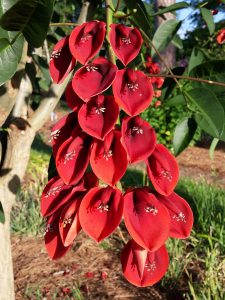
Cockspur Coral Tree (Erythrina crista-galli)
“Tropical” does not necessarily mean “non-native” as there are many Florida natives that provide summer color or texture and are heat loving yet cold hardy in north Florida. These include some palms (cabbage, palmetto, paurotis), ashe magnolia (Magnolia ashei), switchcane (Arundinaria gigantea, a native bamboo), hardy hibiscus (Hibiscus grandiflorus, H. moscheutos and others), golden canna (Canna flaccida), and maypop passionflower (Passiflora incarnata).
Disadvantages of Tropicals
Use of tropicals in your garden does have a downside. Most tropicals are water hogs and need regular irrigation. This isn’t a problem if our area experiences the normal patterns of summer thunderstorms. However, if we don’t receive regular rainfall, tropical plants create the burden of having to water them regularly or else their flowers wilt and leaves droop.
Another disadvantage of tropicals is the “off-season” appearance. Though they thrive in summer heat, they grow slowly during the cooler temperatures of spring and fall and some disappear altogether in winter. Some tropicals are not winter hardy in north Florida and must be replanted each year or undergo elaborate cold protection strategies to help them survive. Other tropicals will over-winter, but often are burned back by frosts, requiring labor to cut back the dead foliage and stems. Finally, tropicals usually require warm weather for growth to resume, and tropicals that die back will produce gaps in your landscape during winter, spring and early summer.
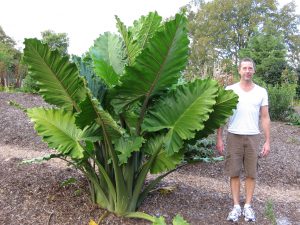
‘Portora’ Giant Elephant Ear (Alocasia sp.)
At the other extreme, some tropicals have such exuberant growth that they are invasive in north Florida. For example, almost all running types of bamboo and many clumping bamboos are invasive, other than those mentioned previously. Also avoid non-native canna (Canna indica), elephant ears (Colocasia and Xanthosoma spp.), Lantana (sterile forms are OK), and some non-native passionvines (Passiflora spp.). If you have questions about a plant’s invasiveness, check the UF/IFAS Assessment of Non-Native Plants in Florida’s Natural Areas, https://assessment.ifas.ufl.edu/.
Using Tropicals in North Florida
Tropicals are best used as accent plants to draw attention in summer when they look their best and the rest of the garden looks its worst. When used as accents, place them throughout the landscape so that winter damage or absences aren’t noticed. Concentrations of tropicals in one area will look great in summer but could look like a mass of dead foliage in winter! To create an entirely tropical-looking planting in north Florida, combine tropical plants with cold-hardy tropical lookalikes (a topic for another time!).
Plant tropicals in late spring once temperatures warm because they will grow slowly or even experience damage at temperatures below 50°F. Best practices for tropicals are to place them in the appropriate exposure for the particular plant (sun, part sun or shade) and keep them mulched. One common characteristic of tropicals is their need for soil moisture, necessitating irrigation to supplement rain. A rich soil or applications of organic mulches or compost can provide nutrients for growth, or light fertilizer applications in summer can boost growth.
Tropicals come alive in the heat of summer. When used in north Florida gardens, tropical plants provide pops of color, luxuriant growth and big, bold, dramatic texture that rescue our gardens from the doldrums of summer!
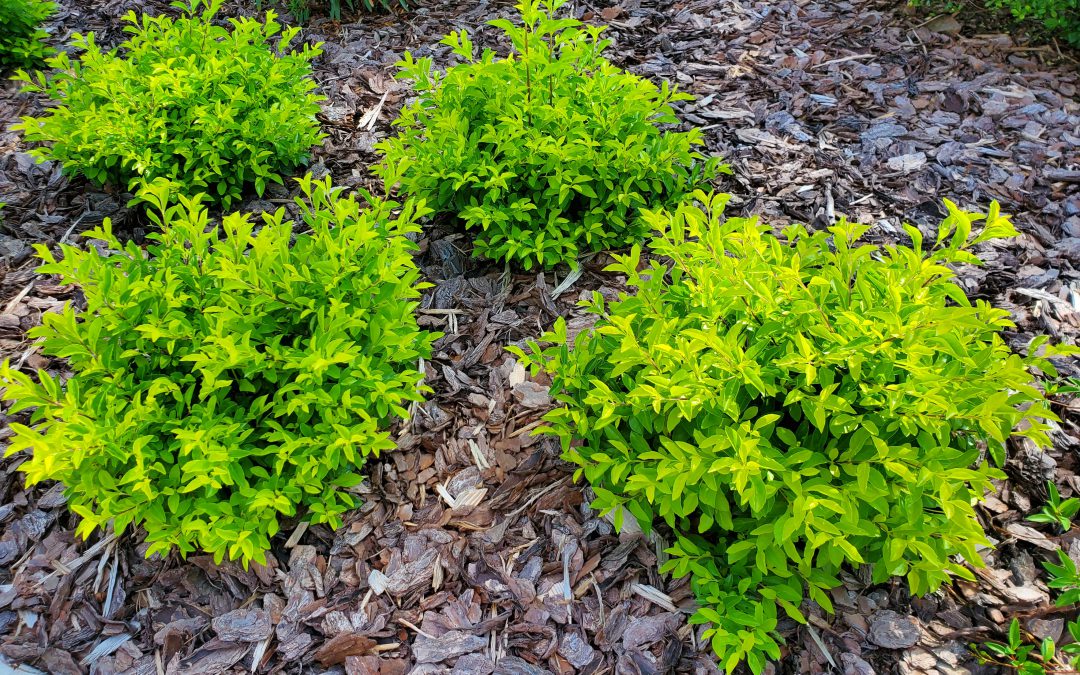
by Daniel J. Leonard | Jul 23, 2020
Flowers can often be fickle in the landscape, so, this year, I decided to add a shot of no-maintenance color to my landscape with foliage plants! The benefits of ornamentals that don’t need flowers to put on a show are many. Their water and fertility needs are often less because they don’t have to support the large energy and irrigation requirements the flowering process demands. They don’t need deadheading to look their best and they lend an awesome texture that is overlooked in many landscapes. My summertime foliage plant of choice provides all those things in a small, bright yellow package; it’s a widely sold selection of Duranta called ‘Gold Mound’.
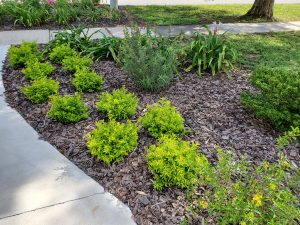
Mass of ‘Gold Mound’ Duranta in the author’s landscape.
‘Gold Mound’ Duranta is a small shrub known for its chartreuse to bright yellow foliage and generally grows 24” or so tall and wide in the Panhandle, allowing it to fit in nearly any landscape. ‘Gold Mound’ has been around in the horticulture trade a long time and is a popular perennial shrub in the southern parts of Florida. It was recognized as the Florida Nursery, Growers, and Landscape Association’s (FNGLA) plant of the year in 2005 and regularly occupies a spot in the color displays of big box and local nurseries, even in the Panhandle, however, despite these attributes, ‘Gold Mound’ is a rare find in Northwest Florida landscapes. That needs to change!
In our neck of the woods, Duranta ‘Gold Mound’ is incredibly low maintenance. I planted a grouping of thirteen specimens near the end of my driveway to provide a consistent season long splash of color to complement the fleeting blooms of the spring flowering shrubs, the drab greenery of the neighbor’s lawn and the on-again, off-again ‘Drift’ Roses they share the bed with. The result has been awesome! I watered frequently until the small shrubs were established and on their own, with no irrigation since. I fertilized at planting with a slow release, polymer coated fertilizer and have not had to help them along with subsequent applications. Even better, despite our frequent rainfall and heat/humidity, no pests or diseases have come knocking. Just because I enjoy gardening doesn’t mean I need a landscape full of divas and I can count on ‘Gold Mound’ to not need pampering.
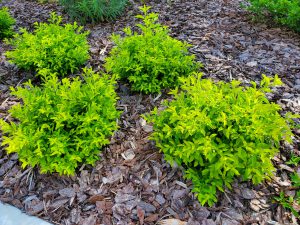
Incredible chartreuse foliage of ‘Gold Mound’.
Maybe my favorite part of ‘Gold Mound’ Duranta in the Panhandle is that it isn’t permanent. Duranta is a native of the Caribbean tropics and is not particularly cold hardy, most Northwest Florida winters knock it back hard, if not outright killing it. Therefore, ‘Gold Mound’ is best enjoyed here as an annual, planted when the weather warms in the spring, enjoyed until the first frost, then pulled up and discarded. Easy peasy. No long-term commitments required. My uncle, the chainsaw gardener, doesn’t even have to chop it back! Just compost the plants each winter or toss them in the trash, hit up your local nursery the next spring for some new plants and do it all over again. Though it has to be replanted each year, Duranta ‘Gold Mound’ won’t break the bank. The generic ‘Gold Mound’ is commonly sold in 4” containers for just a few dollars apiece in the annual section of plant nurseries, making it a very affordable option, especially compared to some of the new, designer perennials it competes with.
Though some landscape designers recommend just using a single specimen of ‘Gold Mound’ here and there for small pops of color, I prefer using groupings of the plant. I’ve seen successful plantings of ‘Gold Mound’ massed in large groups to create annual color beds at key points in landscapes and also planted across the front of a bed to complement darker foliaged backdrop or foundation plants, such as Boxwood or Loropetalum. Regardless of how you decide to use them in your yard, I don’t think you can go wrong with adding some color pizazz to your landscape with the inexpensive, low-maintenance, Florida-Friendly plant, ‘Gold Mound’ Duranta. Happy gardening!




